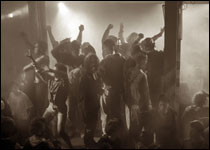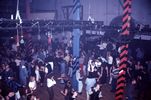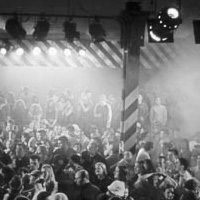 At that stage we didn’t really have a language to deal with it. A review of the new venue in Manchester Evening News that year was headlined PICK YOUR OWN LEVEL – a reference to the then space-age concept of being able to dance, pose or watch from the floor, the balcony or the basement Gay Traitor Bar. The striped road-bollards on the dancefloor were a talking point. Ben Kelly had put them there at a cost of £4.50 each to stop girls (and the occasional boy) getting their high heels stuck in the road-marking cats’ eyes that edged the floor. The inspiration for the whole thing seems to have originated in discussions between Peter Saville and Ben Kelly about their die-cut grille sleeve for the original issue of the first Orchestral Manoeuvres In The Dark LP (who were, of course, then considered quite cool) and some work Kelly had done for a shop called Howie in London. He recently commented that his inspiration really came “from the building itself, and my arrogance in thinking I knew exactly what a club designed for Factory and New Order should look like”.
At that stage we didn’t really have a language to deal with it. A review of the new venue in Manchester Evening News that year was headlined PICK YOUR OWN LEVEL – a reference to the then space-age concept of being able to dance, pose or watch from the floor, the balcony or the basement Gay Traitor Bar. The striped road-bollards on the dancefloor were a talking point. Ben Kelly had put them there at a cost of £4.50 each to stop girls (and the occasional boy) getting their high heels stuck in the road-marking cats’ eyes that edged the floor. The inspiration for the whole thing seems to have originated in discussions between Peter Saville and Ben Kelly about their die-cut grille sleeve for the original issue of the first Orchestral Manoeuvres In The Dark LP (who were, of course, then considered quite cool) and some work Kelly had done for a shop called Howie in London. He recently commented that his inspiration really came “from the building itself, and my arrogance in thinking I knew exactly what a club designed for Factory and New Order should look like”.
The real opening followed the next evening. Seventy-five people looked for corners to hide in while Cabaret Voltaire approximated the sound of several light aircraft colliding. It was clear there were going to be problems. Getting people in, getting people used to it all – a whole new way of going out and sorting out the sound. Some £40,000 had already been spent, but in truth the building had been chosen for its size and its design possibilities above its acoustic properties. Hewan Clarke scribbled a note in 1983 asking for some way of seeing out of his black box and “a pair of monitor speakers to aid in the mixing of records”. These days even footballers have monitor speakers in their bedroom mixing dens.
By the end of the first year a regular membership of post-punk trendies had claimed the space as their own – though Tony Wilson’s pioneering black dance policy for the club was causing some controversy among the white hairdressers who saw an appealing pretension in The Hacienda. “I object to the DJ’s overplaying of funk, jazz, disco or whatever it’s called,” one letter ranted. “After all, not everyone wants to dance to Bauhaus and Patrice Rushen.” DJ John Tracey, now sharing Hewan’s seven-day working week, started playing Gerry Anderson’s Thunderbirds theme so everyone could wheel about in circles with their arms out at the end of the night. The music settled as a schizophrenic mix of Simple Minds and Willie Hutch, Iggy Pop and Sharon Redd. Other end-of-night favourites included Lulu’s “Shout” and the theme from Zorba The Greek. Obviously things were a long way from Ce Ce Rogers’ “Someday” and “Pacific State” at this point.
 By 1985 proper new dance music from various schools was starting to make a real mark on nights like Mike Pickering’s long-running Nude, which began that year. Looking back for the roots of the seismic revolution in club culture that occurred in the Eighties, some place huge emphasis on 1988 – on acid house and the drugs that undoubtedly helped make mass sense of the music. But in real terms, none of that could have happened without the slow – and painful – process of DJs playing Trouble Funk to those who would have preferred Prefab Sprout in the wilderness years between 1982 and 1985. A whole generation of NME readers, completely unaware of jazz funk and Northern Soul, their own rules already written in stone, slowly picked up the idea that you could listen to The Smiths in the daytime while trying to get your head (and your feet) around George Clinton’s “Atomic Dog” at night. The Hacienda, trusted because of its impeccable indie associations (the thinking being, these people brought us Joy Division, how could they be wrong about Cameo?), almost single-handedly took white Manchester beyond the Poly bop mentality and slowly into the black technological futures of electro, funk and disco. The club created a space where new cultural responses to this musical cross-pollination could grow at their own pace. The success of Factory’s own A Certain Ratio in this period, from pale young men to whistle-blowing funkateers, convincingly showed how things changed. At first the music acted as a kind of sonic seasoning – tolerated, often grudgingly accepted, then, with increasing enthusiasm, requested. The Hacienda’s progressive attitude at this time ensured that when pre-movement house music began to appear, those seeing the rhythmic holes in funk-lite white pop were ready.
By 1985 proper new dance music from various schools was starting to make a real mark on nights like Mike Pickering’s long-running Nude, which began that year. Looking back for the roots of the seismic revolution in club culture that occurred in the Eighties, some place huge emphasis on 1988 – on acid house and the drugs that undoubtedly helped make mass sense of the music. But in real terms, none of that could have happened without the slow – and painful – process of DJs playing Trouble Funk to those who would have preferred Prefab Sprout in the wilderness years between 1982 and 1985. A whole generation of NME readers, completely unaware of jazz funk and Northern Soul, their own rules already written in stone, slowly picked up the idea that you could listen to The Smiths in the daytime while trying to get your head (and your feet) around George Clinton’s “Atomic Dog” at night. The Hacienda, trusted because of its impeccable indie associations (the thinking being, these people brought us Joy Division, how could they be wrong about Cameo?), almost single-handedly took white Manchester beyond the Poly bop mentality and slowly into the black technological futures of electro, funk and disco. The club created a space where new cultural responses to this musical cross-pollination could grow at their own pace. The success of Factory’s own A Certain Ratio in this period, from pale young men to whistle-blowing funkateers, convincingly showed how things changed. At first the music acted as a kind of sonic seasoning – tolerated, often grudgingly accepted, then, with increasing enthusiasm, requested. The Hacienda’s progressive attitude at this time ensured that when pre-movement house music began to appear, those seeing the rhythmic holes in funk-lite white pop were ready.
“The Hacienda didn’t change us – we changed The Hacienda. It all went off under the balcony in the left-hand corner”
Bez [ Vibes Controller, Happy Mondays ]
John Tracey’s The End: A No Funk Night died a natural death at the end of 1984. By 1986 electro legend Greg Wilson had a night at the club, playing the solidly black percussive New York sound to a set of new faces. For the princely sum of £3.50 you could have seen Grandmaster Flash And The Furious Five dressed like The Glitter Band. A real eye-opener for some who still thought a party was listening to Throbbing Gristle records doing hot knives round your mate’s house. A great many people, myself included, had their lives, or at least their taste in music, changed by the pre-house Hacienda. We were all learning together. As the summer of 1986 arrived, The Hacienda was full with what is quaintly described in its own records as “a band-less disco”; it was starting to make money too, and Paul Mason became manager of the club, poached from a successful Rock City in Nottingham, to keep it that way. Paul remembers his induction during a Factory-style board meeting where Rob Gretton – in a heated discussion with Tony Wilson – threw his chips at him. Tony and Rob ended up grappling on the floor. Sadly, there are no pictures.
And then the bomb dropped – with no warning that I can remember, apart, perhaps, from DJ Jon Da Silva’s siren sound effects. People always use the phrase {ln:Acid House – The History ‘Acid House}. To me that has never made any sense. In the beginning, as somebody with a deep voice used to say, there was house. Records with singing in them, almost like gospel with big, pushy rhythms and vaguely spaced dubs. House certainly sounded new back then (obviously we weren’t as clever as we are now in spotting the disco roots of the sound), but it was still polite. {ln:Acid House – The History ‘Acid} was a different sound altogether – menacing, growling, ungrateful and volatile, at its best like a starved dog prowling in circles. The Chicago House Party Tour which stopped at the club in March 1987 with {ln:Frankie Knuckles}, {ln:Marshall Jefferson ‘Marshall} and the rest of them getting their first taste of gullible limeys paying through the nose for their instinctive magic, showed that house, now a big part of nights like Nude and Wide, was here to stay. At least for a while. But Acid sounded like coded radio sig- nals, a kind of dance instruction from another planet. At least until some wayward holidaymakers brought us all a present back.
“I went to the opening night at The Hacienda. We used to laugh at the black-and-white `Factory’ types that filled it – so serious, so Dada, so Eighties. I remember being there one night looking at thousands of boys and girls E-ing out of their minds, all in sync, possessing a kind of energy that rose and swelled and then totally let go. Here’s to another 15 years”
According to Shaun and Bez, interviewed some time after the event and not usually known for being good with dates, some of their mates had been away on holiday in Valencia and Ibiza and had brought back some Ecstasy tablets. People tried them out and they seemed to fit the music perfectly. Many lost their inhibitions overnight – feeling comfortable enough to get on stages and podiums and wave their arms about in a state of, well, ecstasy – hearing things in the music that they couldn’t hear before. A new low-rent crowd started mixing with the converted hairdressers and Factory obsessives of old. It was, at times, a volatile mix. But the drugs turned an often socially confused crowd into one sweaty nation, under the influence of a groove twisted out of a small silver box ({ln:Roland TB-303 ‘The Roland TB-303} invented by Japanese technicians to provide a kind of karaoke backing for social-club country and western singers.
